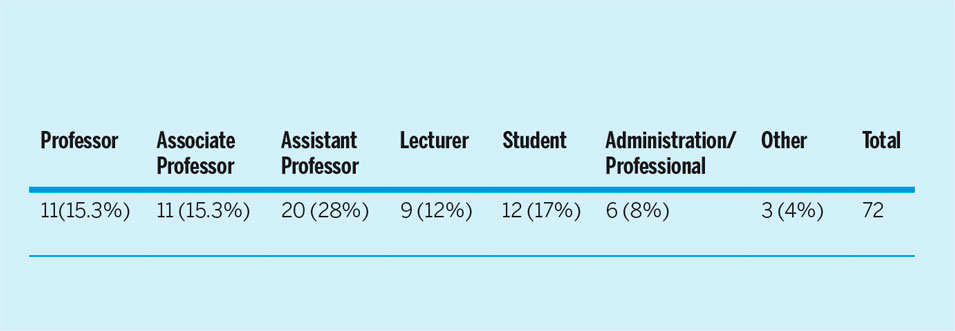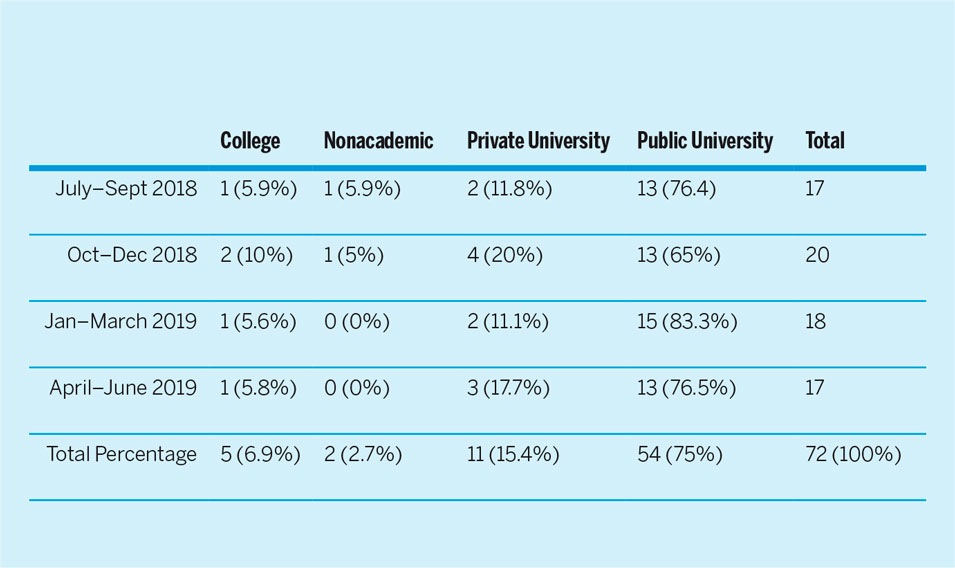The editorial team for the Journal of Political Science Education has now been running the journal for the last three years with support from APSA and specifically from Jon Gurstelle, Director of Publications for APSA. In our third year working on the journal the process has gone well and we have a good team of managing editors and editorial assistants at the University at Albany and Roger Williams University.
HIGHLIGHTS FROM OUR 3RD YEAR
Now ending our third year as an APSA-wide journal, we have seen submissions go up since we took over the journal (though down a bit from last year). We are getting a good number of submissions from authors for all four sections of the journal: Scholarship of Teaching and Learning (SoTL); Political Science Instruction, Teaching Tools, & Educational Resources; Reflections on Teaching and the Academy; and book reviews. In the past year, we have made progress in our effort to improve social media engagement, with our Twitter account (@JPSE_Editors) regularly tweeting about pedagogy-related issues and announcing JPSE articles as they are released. That being said, we plan to increase Twitter activity this coming year, hopefully improving on our current follower count of 300.
One important decision the editorial team made this year was to discontinue yearly special issues in response to lower submission numbers for these issues. Instead, we decided to invite submissions for special sections so that we would not be dependent on getting enough manuscripts to fill each of the four sections of the journal on one topic for one issue. Last year, nearly 50% of author submissions came from women. This year, 56% of the published authors in JPSE were women (see table 1). In terms of publicizing the journal, we once again hosted a “Meet the Editors” roundtable at the 2019 APSA Annual Meeting. In summary, our team has enjoyed this third year and we are looking forward to continuing to grow the journal and its outreach as an APSA-wide journal.
Table 1 Authors by Gender

Parentheses–Percentage of Total including coauthors, all original submissions
STAFFING
Our staff at the Journal of Political Science Education consists of six co-editors who are using a portion of their time to work as a team as well as specifically on their own section of the journal. Two student managing editors and two editorial assistants work part-time on the journal. Our current managing editors are Mirren Galway and Olivia Vecchio who will be continuing this year. Both managing editors are students at the University at Albany SUNY. Margaret Bidwell, and Tatevik Khachatryan, students at Roger Williams University, are currently serving as editorial assistants and will continue to do so this coming year.
PRODUCTION AND DELIVERY
Author Demographics
The demographic distribution of the Journal of Political Science Education authors is reported in tables 1, 2, and 3. We should note that Taylor & Francis does not collect other demographic data. Currently, 56% of our article authors are women—a 9% increase from last year. Our authors also represent different ranks, with assistant professors (28%) accounting for more submissions than any other rank. 30.6% of articles came from tenured faculty. There was a slight decrease in international submissions this year, down from 13.1% to 12.8%. However, a greater number of countries (eight) were represented in this year’s submissions. Table 4 shows the distribution of authors by type of institution for accepted papers.
Table 2 Authors by Rank

Parentheses–Percentage of Total including coauthors, all original submissions
Table 3 Authors by Country of Submission

Parentheses–Percentage of Total including coauthors, all original submissions
Table 4 Authors by Type of Institution

Parentheses–Percentage of Total including coauthors, all original submissions
Content and Treatment of Manuscripts
The number of manuscripts submitted has decreased from 99 last year to 81 this year, but that this is still up dramatically from 40 in the first year of the journal. Table 5 shows the submissions of manuscripts to each of the journal’s sections, while Table 6 shows the manuscript decisions. Our current rejection rate is 31%, an increase of 12%. Table 7 presents information on reviewer statistics. The percentage of completed reviews has decreased from 70% last year to 66% this year but remains above the percentage of the first year. Table 8 provides data on the average reviewer turnaround time. This table reflects a slight improvement in turnaround time by the editorial board—from 27.86 days last year to 26 this year—and slight increase in turnaround time by reviewers from 28.79 days last year to 31.15 days this year.
Table 5 Types of Submission

Parentheses–Percentage of Total, all original submissions
Table 6 Manuscript Decision (Original Submissions)

* This is the percentage of all rejected manuscripts, not of all new manuscripts
Parentheses–Percentage of Total, all original submissions
Table 7 Reviewer Statistics

Table 8 Average Reviewer Turnaround Time

Makeup of the Editorial Board
Table 9 shows the gender makeup of the editorial board of JPSE. Table 10 shows the distribution of the board by type of institution, with most of the board working at public universities. Table 11 shows that most of the editorial board is from the United States, except for four international members.
Table 9 Ed. Board by Gender

Parentheses–Percentage of Total
Table 10 Editorial Board by Type of Institution

Table 11 Editorial Board by Country

Table 12 Editorial Board by Rank

Parentheses–Percentage of Total including coauthors, all original submissions
Publicity and Outreach
The editors of the Journal of Political Science Education are working to increase our publicity and outreach. We are continuing to ask authors to provide a 50-word blurb and a 130-character tweet, many of which have been shared on PSNow. We plan to continue attending each Teaching and Learning and APSA-wide conference, holding “Meet the Editors” tables where we can reach out to potential authors about submitting to the journal. When it is possible, members of our editorial team have organized such events at regional APSA conferences, and we plan to continue to do so.














